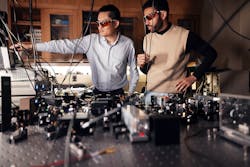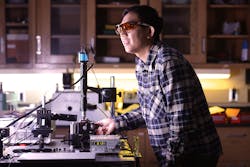Entanglement-enhanced optomechanical sensors offer unprecedented precision
A team of researchers led by Zheshen Zhang, an associate professor of electrical and computer engineering at the University of Michigan (Ann Arbor, MI), is exploiting quantum entanglement to provide optomechanical sensors with unprecedented measurement sensitivity and speed—making them 40% more precise and 60% faster than two unentangled beams (see video).
“Entanglement is a radically new physical phenomenon within the framework of quantum mechanics,” says Zhang. “Albert Einstein, Boris Podolsky, and Nathan Rosen initially used entanglement in a thought experiment to refute the foundation of quantum mechanics, but their attempt of course didn’t result in the collapse of quantum mechanics. To the contrary, with more thorough theoretical and experimental studies carried out during the past century, entanglement is now recognized as a pillar of modern physics and is being leveraged to develop quantum information technologies.”
The 2022 Nobel Prize in Physics was awarded to three pioneers whose work validated quantum entanglement as a physical reality.
“My team is taking the next step to explore entanglement to boost the performance of sensors,” Zhang says. “Since entanglement is a fundamentally new resource, it may allow us to achieve unprecedented measurement precision beyond the reach of classical physics—creating exciting opportunities to advance a variety of realms.”
In optomechanical sensing, mechanical oscillators respond to external forces, magnetic and acoustic signals, while optical probes read out the motion of mechanical oscillators to infer the external signal. Researchers can use an array of optomechanical sensors to scale up measurement performance, but the measurement precision of optomechanical sensors is fundamentally limited by the measurement noise arising from quantum fluctuations of the probe light and mechanical oscillators.
Entangled sensors offer counterintuitive scaling improvement
During the team’s experiment, which was done at the University of Arizona before Zhang moved to Michigan, they created entanglement between optical probes to suppress the fundamental measurement noise and enhance measurement performance.
The team’s entangled sensor relies on two synchronized laser beams, with one beam reflected from the sensor (see Fig. 1). Any movement within the sensor changes the distance the light travels on its way to the detector, and this difference shows up when the second wave overlaps the first wave. If the sensor isn’t moving, the two waves remain perfectly aligned—but if the sensor moves, it creates an interference pattern as the peaks and troughs of their waves cancel each other out. And this pattern reveals the size and speed of vibrations within the sensor.“My student Yi Xia was the lead experimentalist on the project and managed to assemble a very nicely engineered system to demonstrate the fundamental principles of entanglement-enhanced optomechanical sensing,” says Zhang.
Quest for dark matter and gravitational waves gets a new tool
The main applications of the team’s work will likely be for ultraprecise measurements needed on the quest to explore new physics such as dark matter and gravitational waves.
“Dark matter remains elusive due to a lack of high-precision measurement apparatuses,” says Zhang. “By drastically improving the precision of optomechanical sensors using entanglement, we may get into a regime to observe some of the long-sought-after dark matter particles to deepen our understanding of nature. Moreover, this technique could facilitate navigation in GPS-absent conditions to strengthen the safety of autonomous vehicles when driving through tunnels and in garages.”
Zhang’s team is currently working on integrated quantum chips for entanglement-enhanced sensing (see Fig. 3). Assembling all of these components on-chip will eliminate the need for optical alignment and make the sensors much more stable—and overcome the two main challenges of their current experiment.“Our continued work is supported by the National Science Foundation’s Convergence Accelerator program, with partners from multiple universities and companies,” he says. “And our vision is to miniaturize the proof-of-concept entanglement-enhanced optomechanical sensing experiment to chip-scale size so it can become more affordable, mass producible, and widely accessible.”
Their goal is to deliver a quantum sensor chip prototype within a year or two, followed with a pathway to manufacturing and commercialization.
FURTHER READING
Y. Xia et al., Nat. Photon. (2023); https://doi.org/10.1038/s41566-023-01178-0.
About the Author
Sally Cole Johnson
Editor in Chief
Sally Cole Johnson, Laser Focus World’s editor in chief, is a science and technology journalist who specializes in physics and semiconductors.



